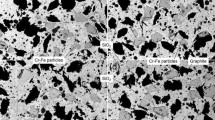Abstract
The search for suitable friction materials for high-speed train is an attractive but difficult problem. In recent years, a variety of different novel friction materials were fabricated to meet the aims of high loads and speeds under ambient environment. Carbon fiber-reinforced carbon composites (C/C), carbon fiber-reinforced silicon carbide composites (C/C-SiC) and metallic composites fabricated by powder metallurgy are three excellent materials among them. Here a comparison of these three different materials working as brake pads, coupled with high-density C/C-SiC brake disk, was described. All the experiments were conducted using the same procedure with increasing initial braking speed (the rotation speed of brake disk at the beginning of braking process) from 30 to 59 m/s and constant load of 1.25 MPa, simulating the real working condition of high-speed train. The coefficient of friction (COF) and wear rates of three materials were compared and analyzed. During experiments, the COF of metallic and C/C pads remains nearly constant at 0.31 and 0.22, respectively, with increasing braking speed, while that of C/C-SiC exhibits a parabola. These different trends of COF may be attributed to the distinctive forming processes of friction film on the top of contact surfaces. Meanwhile, the wear rates of metallic composites increase rapidly from 683 to 1803 mm3/MJ with initial braking speed, while C/C-SiC presents the highest wear loss of 1887 mm3/MJ at 49 m/s and lowest value of 315 mm3/MJ at 59 m/s. Interestingly, the wear rate of C/C composites, due to the appropriate bonding strength of matrix/fiber and relatively high shear stress, decreases from 3698 to 903 mm3/MJ with increasing initial braking speed, which does not consist with pre-existing paper. Thus, metallic pads presented the lowest wear rates at lower speed (<49 m/s) but the highest at high speed, while C/C-SiC composite pads showed the greatest wear resistance at high speed. This investigation of three different friction materials will enhance our understanding of these friction materials and benefit the selection and safe application of high-speed train friction materials.








Similar content being viewed by others
References
Xiong, X., Chen, J., Yao, P., Li, S., Huang, B.: Friction and wear behaviors and mechanisms of Fe and SiO2 in Cu-based P/M friction materials. Wear 262, 1182 (2007)
Chen, B., Bi, Q., Yang, J., Xia, Y., Hao, J.: Tribological properties of solid lubricants (graphite, h-BN) for Cu-based P/M friction composites. Tribol. Int. 41, 1145 (2008)
Cui, G., Niu, M., Zhu, S., Yang, J., Bi, Q.: Dry-sliding tribological properties of bronze–graphite composites. Tribol. Lett. 48, 111 (2012)
Sarkar, S., Badisch, E., Mitra, R., Roy, M.: Impact abrasive wear response of carbon/carbon composites at elevated temperatures. Tribol. Lett. 37, 445 (2010)
Lei, B., Yi, M., Xu, H., Ran, L., Ge, Y., Peng, K.: Effect of resin-derived carbon on the friction behavior of carbon/carbon composites. Tribol. Lett. 41, 371 (2011)
Zhou, H., Dong, S., Ding, Y., Wang, Z., Wu, D.: Friction and wear properties of 3D carbon/silicon carbide composites prepared by liquid silicon infiltration. Tribol. Lett. 37, 337 (2010)
Fan, S., Zhang, J., Zhang, L., Cheng, L., Tian, G., Liu, H.: Tribological properties of short fiber C/SiC brake materials and 30CrSiMoVA mate. Tribol. Lett. 43, 287 (2011)
Brahney, J.H.: Carbon-carbon-heat means strength. Aerosp. Eng. (United States) 7, 11 (1987)
Buckley, J.D.: Carbon-carbon-an overview, Am. Ceram. Soc. Bull. 67(2), 364 (1988)
Fitzer, E.: Carbon Reinforcements and Carbon/Carbon Composites. Springer, Berlin (1998)
Fitzer, E.: The future of carbon-carbon composites. Carbon 25, 163 (1987)
Cai, Y., Yin, X., Fan, S., Zhang, L., Cheng, L., Wang, Y., Yin, H.: Effects of particle sizes and contents of ceramic fillers on tribological behavior of 3D C/C composites. Ceram. Int. 40, 14029 (2014)
Heidenreich, B., Krenkel, W.: Development of C/C-SiC Materials for Friction Applications, 455 pp. Wiley-VCH Verlag GmbH & Co. KGaA, Weinheim, Germany (2000)
Rak, Z.S.: Cf/SiC/C Composites for Tribological Application, 820 pp. Wiley-VCH Verlag GmbH & Co. KGaA, Weinheim, Germany (2001)
Vaidyaraman, S., Purdy, M., Walker, T., Horst, S.: C/SiC Material Evaluation for Aircraft Brake Applications, 802 pp. Wiley-VCH Verlag GmbH & Co. KGaA, Weinheim, Germany (2001)
Y. Wang, Q. Yan, Z. Fan, X. Wen, C. Ge.: Frictional performance and friction film evolution of Cu based braking materials. In: Proceedings of the Second International Conference on Railway Technology: research, development and maintenance in France (2014). doi:10.4203/ccp.104.313
G. Li, Q. Yan, J. Xi et al.: The stability of the coefficient of friction and wear behavior of C/C-SiC. Tribol. Lett. 58(1), 1 (2015)
Cai, Y., Fan, S., Liu, H., Zhang, L., Cheng, L., Dong, B., Jiang, J.: Microstructures and improved wear resistance of 3D needled C/SiC composites with graphite filler. Compos. Sci. Technol. 69, 2447 (2009)
Yen, B.K., Ishihara, T.: On temperature-dependent tribological regimes and oxidation of carbon-carbon composites up to 1800 °C. Wear 196, 254 (1996)
Fan, S., Zhang, L., Cheng, L., Tian, G., Yang, S.: Effect of braking pressure and braking speed on the tribological properties of C/SiC aircraft brake materials. Compos. Sci. Technol. 70, 959 (2010)
Stadler, Z., Krnel, K., Kosmač, T.: Friction and wear of sintered metallic brake linings on a C/C-SiC composite brake disc. Wear 265, 278 (2008)
Lei, B., He, L., Yi, M., Ran, L., Xu, H., Ge, Y., Peng, K.: New insights into the microstructure of the friction surface layer of C/C composites. Carbon 49, 4554 (2011)
Ozcan, S., Filip, P.: Microstructure and wear mechanisms in C/C composites. Wear 259, 642 (2005)
Gouider, M., Berthier, Y., Jacquemard, P., Rousseau, B., Bonnamy, S., Estrade-Szwarckopf, H.: Mass spectrometry during C/C composite friction: carbon oxidation associated with high friction coefficient and high wear rate. Wear 256, 1082 (2004)
McKee, D.W.: Oxidation behavior and protection of carbon/carbon composites. Carbon 25, 551 (1987)
Acknowledgments
The financial support from National Natural Science Foundation of China under Contract No. U1134102 is gratefully acknowledged.
Author information
Authors and Affiliations
Corresponding author
Rights and permissions
About this article
Cite this article
Li, G., Yan, Q. Comparison of Friction and Wear Behavior Between C/C, C/C-SiC and Metallic Composite Materials. Tribol Lett 60, 15 (2015). https://doi.org/10.1007/s11249-015-0591-5
Received:
Accepted:
Published:
DOI: https://doi.org/10.1007/s11249-015-0591-5




